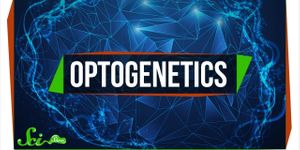Getting Loopy - How DNA is Organized
Each one of our cells carries over two meters of DNA, which has to be neatly packaged. For decades, the exact details of this process have remained mysterious. The mechanism has now been merely filmed by investigators at the Kavli Institute of Delft University and EMBL Heidelberg. They saw in real time that a protein complex called condensin organizes the DNA into loops. By releasing loop after loop, the genome is thus compacted to a manageable size, and after a cell divides, the resulting two cells each get the right stuff. The work has been reported in Science.
This work should settle a lengthy debate. Before cell division, DNA is a jumbled mess that must be made into chromosomes so that after it divides, the genetic material is appropriately distributed. It was known that condensin played an important part, but exactly what that role was has been unclear. Was condensin grabbing and connecting the DNA? Was it pulling the DNA inwards? The answer was elusive.
Previous work by scientists at Delft and collaborators demonstrated that condensin has the ability to perform loop extrusion. However, their study left some unanswered questions, and concrete proof that condensin was organizing the DNA was still absent.
Scientists have now found it by purifying, labeling, and filming the protein in action. Researchers at the Cees Dekker group at the Kavli Institute of Delft University and from the Christian Haering group from EMBL Heidelberg showed that the condensin complex can indeed extrude loops of DNA.
"We've simply proved it by filming it," said author Mahipal Ganji, a postdoc in the group of Cees Dekker at Delft. "DNA is such an entangled mishmash that it is very difficult to isolate the process and study it in cells. In our study, the first step was to fix the two ends of a DNA molecule onto a surface and put color dyes on the DNA and condensin. By then applying a flow in the fluid perpendicular to the molecule, we oriented the DNA in a U-shape and brought it into the focal plane of our microscope. Amazingly, we could then see a single condensin bind and extrude a loop."
"This settles the debate," added Professor Cees Dekker. "These data provide compelling evidence that condensin reels in DNA to form loops. Our novel imaging approach also allows measurement of all kinds of quantitative data: the symmetry of the loop extrusion, the speed at which the loop is formed, what happens when you pull on the DNA."
When the investigators measured the looping speed, they found it to be quite high; condensin reels in about 1500 DNA base pairs every second. It is also very efficient, using only small amounts of cellular fuel called ATP for the process. That suggests that instead of pulling the DNA base by base, it grabs in large chunks. The process can be slowed down by pulling on the DNA as well. That tension impedes the process, and condensin has a harder time making loops. The process was also observed to be asymmetrical.
"We saw that condensin docks onto DNA and anchors itself there, and then starts reeling in DNA from one side only." Dekker noted, "Yet another interesting finding."
Condensin has been associated with human disease, and errors in DNA organization can cause cancer. Getting down to the mechanistic details of basic biology will ultimately help create therapeutics for disease.
Sources: Phys.org via Delft University of Technology, Science








